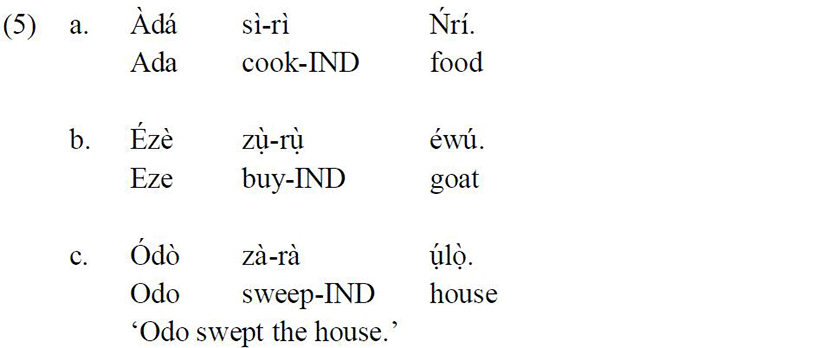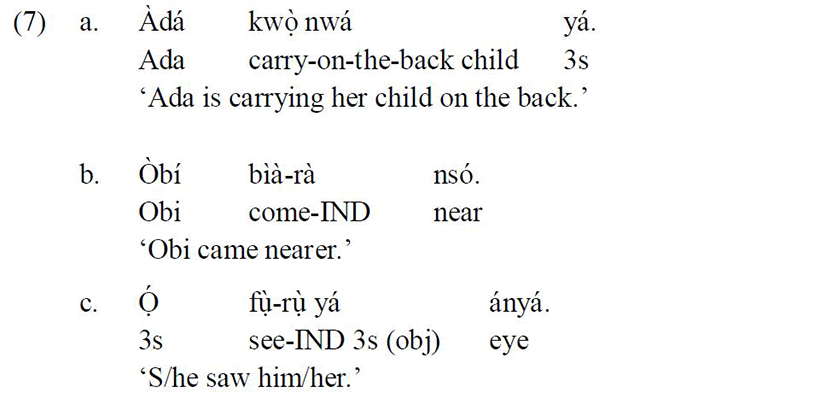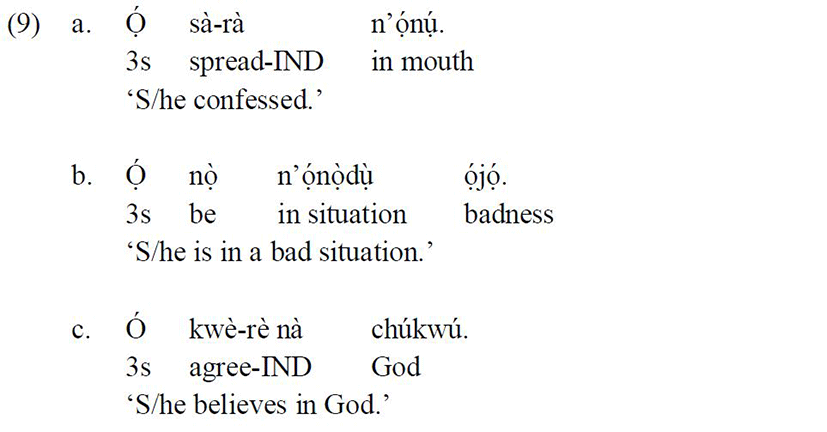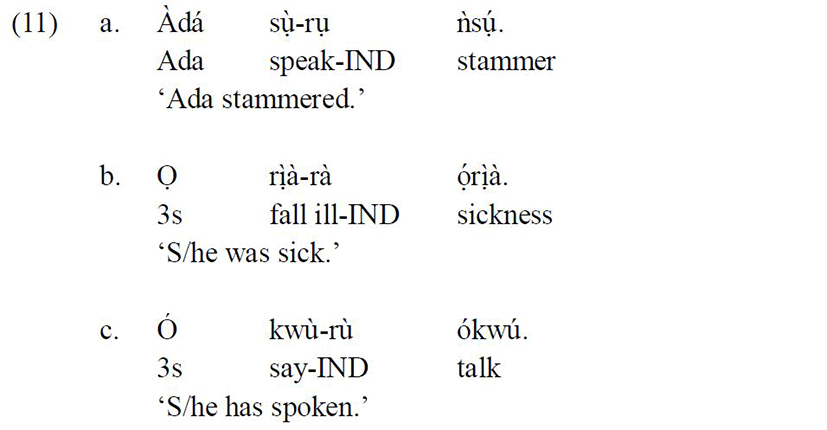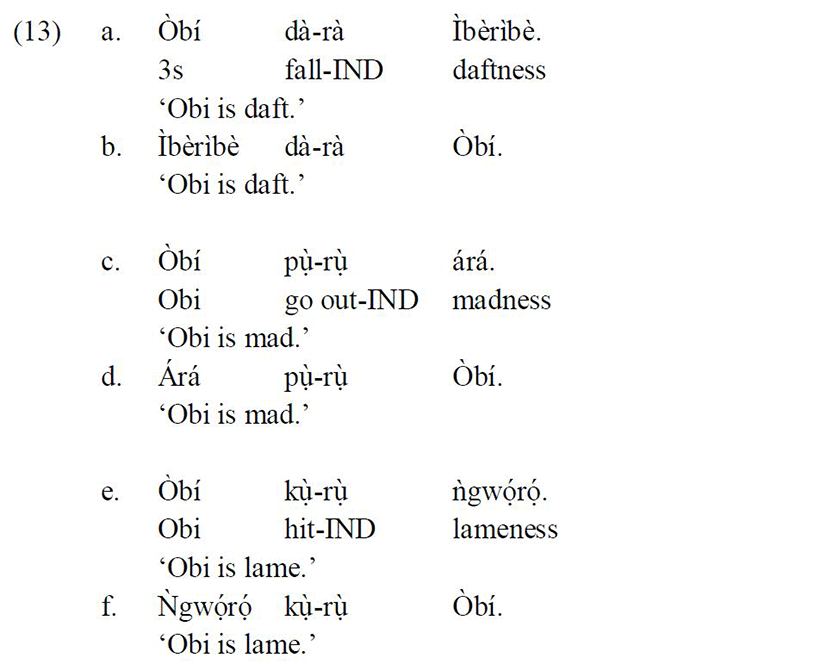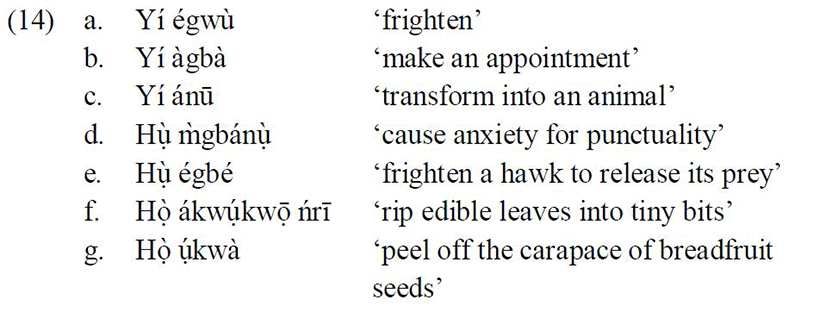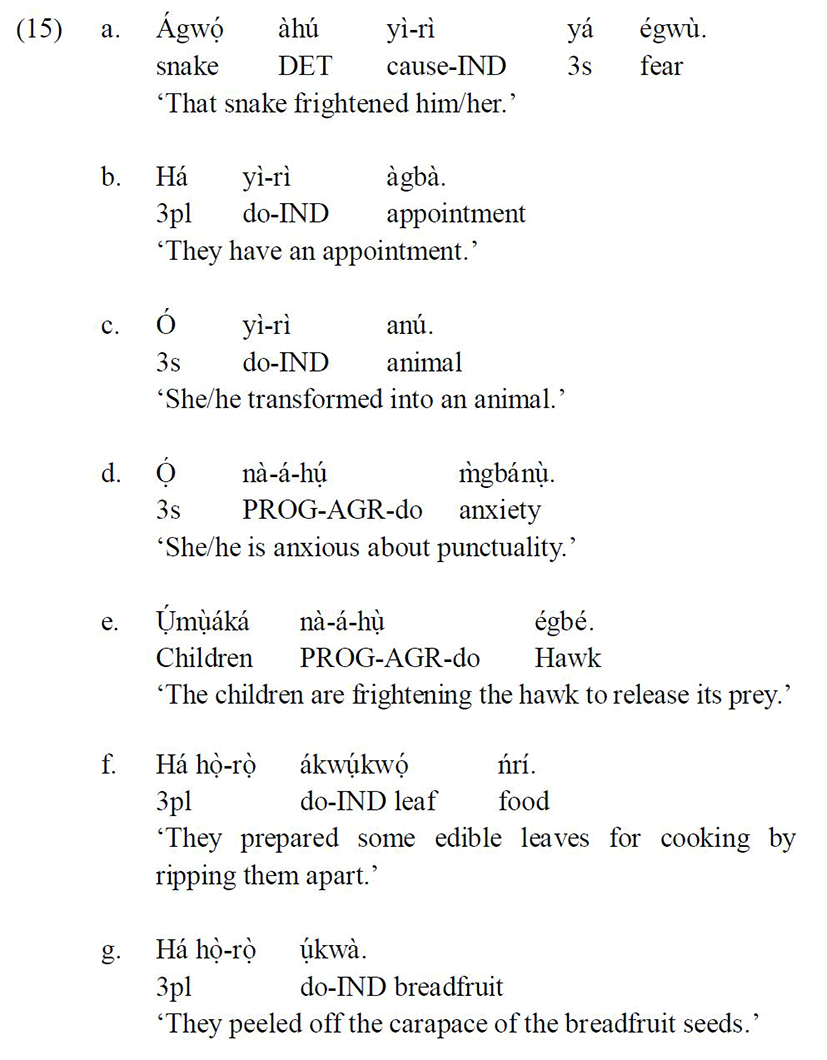1. Introduction
Causativity and transitivity are universal concepts in grammar. The analyses of these two concepts usually involve a complete description of the features of the basic clause of a language. This assertion regarding causativity is cited in Comrie (1985: 165). Halliday (1968) and Hopper & Thompson (1980) make similar assumptions for transitivity, where they claim that transitivity is a feature of the entire clause. Lakoff & Johnson (1980: 69) describe causativity as the way human beings organise ‘their cultural and physical realities.’ This notion is further elaborated at the clause level by Langacker (1987: 54-55)., where he asserts that a prototypical causative clause involves an agent and a patient. This agent does something that tangibly effects a change in the patient. This influences the conceptualisation of causativity by Fleck (2002) who states the conditions that are necessary for a causative situation to occur. Agbo (2014: 4) enumerates these conditions. The first condition is that the speaker realises the sequential occurrence of the events, and believes that the occurrence of one event, T2 (the time of the caused event), has been realised at T1 (the time of the causing event) and that T2 occurs after T1. The second condition is that of the dependency relations between the two events. This means that the occurrence of the caused event, T2, is absolutely dependent on the causing event, T1, and that the speaker is able to deduce from the sequence of events that in an ideal situation, T2 cannot take place without T1 taking place.
Halliday (1968: 179) conceptualises transitivity as ‘the experiential component of meaning’ which involves all the features of the clause including the verb, arguments and other extra-linguistic features. This definition includes the fact that a clause consists of two participants (an agent and a patient), where action depicted by the verb is effectively transferred from the agent to the patient. These definitions of causativity and transitivity would be adopted in the analyses in this paper.
This paper is motivated by the inter-face in the morpho-semantic features of causativity and transitivity in Igbo1. These features when discreetly analysed make known the finer distinctions between these two grammatical concepts. Therefore, the objective of the paper is to investigate the contrasts in the morpho-semantic features of transitivity and causativity. The data for the study is adapted from the previously published works of Agbo & Yuka (2011) and Agbo (2014, 2015).
The paper is further motivated by the fact that causativity and transitivity are yet pertinent issues in Igbo grammar. While there is a paucity of literature on causativity, the literature on transitivity is hitherto contentious with a number of unresolved issues. Therefore, in trying to decipher the differences and similarities between the morpho-semantic features of causativity and transitivity, this paper would make clearer the understanding of the two concepts. This would, hopefully, also enhance the literature on causativity and transitivity in Igbo. An appraisal of published literature on causativity and transitivity is necessary for a clearer perspective on these issues in Igbo grammar. This is done in the next section of this paper.
As already pointed out, there is a negligible literature on causativity in Igbo. More so, a majority of the studies on the subject are not focused on causativity per se but reflect the intuitive acknowledgements of causativity in the language. For example, causativity as a grammatical feature of compound verbs is casually mentioned in the works of Lord (1975), Uwalaka (1988, 1995), and Mbah (1999). These studies have been motivated by the theoretical underpinnings of Transformational-Generative Grammar. Anyanwu (2005, 2007) also adopts the formalist approach of the Minimalist Programme for Linguistic Theory to discuss causativity in Igbo. Nevertheless, Anyanwu (2007) is a very detailed attempt on the study of causativity as it gives an expository analysis of the many types of syntactic derivations involved in causativity in Igbo. Agbo (2014, 2015) argue that the aforementioned studies do not represent the native speaker’s intuitions about causativity because of the formalist approach to their analyses. Therefore, Agbo (2014, 2015) adopt a descriptive methodology to the study of causativity, in order to analyse data that is more intuitively amenable to the native speaker.
The studies on transitivity in Igbo have focused invariably ‘on the rigid split of Igbo verbs into transitive and intransitive classes’ (Agbo & Yuka 2011: 33). This concentration on the classification of transitive and intransitive verbs is overwhelmingly represented in such works as Emenanjo (1975, 1978, 2005, 2012), Ubahakwe (1976), Nwachukwu (1984), Uwalaka (1988), and Uchechukwu (2012). This line of investigation is motivated by the facts of Igbo, where the study of any class of the Igbo verb amounts to the study of the grammar of the language (Uwalaka 1988).
However, Agbo & Yuka (2011) point out that concentrating on the features of an isolated verb in the study of transitivity is misleading. This assertion is supported by the analyses in other languages, where transitivity is a feature of an entire clause and not only the verb. In addition, the entire clause is ranked as ‘more or less’ transitive according to a scale of morpho-syntactic and semantic parameters (Hopper & Thompson 1980). Agbo & Yuka (2011) conclude that Igbo verbs occur in clauses that are ranked according to their transitivity features. This ranking shows that transitivity is a continuum with clauses at one end of the continuum having high transitivity and at the other end are clauses with low transitivity.
The studies of causativity and transitivity in Igbo inadvertently describe the event structures of the Igbo clause. Therefore, an analysis of these event structures would give more insights on the differences and similarities between causativity and transitivity. The rest of the paper is organised thus. In Section 1.1.1 the concept of event structure is discussed. The Igbo predicate structure is discussed in Section 1.1.2 while the event and predicate structure of the Igbo verb is discussed in Section 1.1.3. The conceptualisation of events in the Igbo predicate structure is the topic of Section 1.1.4. Section 2.0 discusses the event structure of causative verbs while Section 3.0 is the conclusion of the study.
The term event includes the conceptualisation of what a predicate represents. In other words an event can be defined by the predicate structure of the language. This structure may be a single lexical item, a verb and its affixes or complements, or a monomorphic predicate (Jarkey 2010). According to Rappaport Hovav et al. (2010), amongst the fundamental functions of language is the division of the fluid nature of the happenings in the world into units, which speakers refer to as events. Rappaport Hovav et al. (2010) further postulate that this segmentation of the happenings in the world facilitates the logical representation of sentences. This logical representation of sentences stimulated the development of event semantics. The framework of event semantics shows that verbs are usually predicates of events but other linguistic units like the arguments and the morpho-syntactic features of the verb are involved in the description of specific events, otherwise known as event structure.
Croft (1990) proffers the view of causativity as events. This view leads him to postulate three ways of conceptualising causativity. These include the localist, the aspectual, and the causal views of causativity. In the localist approach, causativity is viewed as one event causing another event. In the aspectual approach, the view is that individuals bring about events while in the causal approach individuals act on other individuals to bring about events.
Gisborne (2010) draws attention to the relevance of Croft (1990) to the transitivity alternations discussed in Levin (1993). In other words, Gisborne (2010: 76ff) implies that the transitivity alternations discussed in Levin (1993: 25ff) include the description of events. Hence, causativity and transitivity portray events as discussed in this section. The problem, as already stated, is to investigate the differences and similarities between the event structures of causativity and transitivity in Igbo. In order to facilitate this study, it is pertinent to discuss the Igbo predicate structure since events are represented by the predicate structure of a language.
A predicate is the part of a clause or sentence traditionally seen as representing what is said of or predicated of the subject (Matthews 1997: 291). Bowers (2001), adopting a formal semantics approach, views a predicate as ‘an unsaturated expression’ that must combine with an entity in order to form a proposition. Based on these views of the predicate, the Igbo predicate structure includes the Igbo verb and its morpho-semantic structure. These morpho-semantic features are well-captured in Emenanjo (2005) classification of the Igbo verb. The general consensus is that a lexical representation of the verb includes the verb root and some form of morphological extensions. This has been formalised in the timeless definition of the Igbo verb as being ‘made up of three mutually obligatory and complementary elements.’ These obligatory elements comprise the verb itself, the complement and the bound cognate noun (Emenanjo 1975, 1978, 2005, 2012). In other words, the occurrence of the Igbo verb in any syntactic construction represents this assertion. The description of examples in (1)-(3) below, also mentioned in Agbo (2014: 9-10)2, illustrate this fact.
In (1) above, the verb mé ‘make/do’ obligatorily co-occurs with the nominal element m̀mèmmé ‘feast’. The claim here is that every Igbo verb must co-occur with a nominal element which serves as its complement. The idea of the bound cognate noun is illustrated in (2) below.
Émé is a morphological derivation of the verb mé ‘do/make’ and it serves as an emphasiser morpheme. In the literature this is known as the Bound Cognate Noun or BCN. All Igbo verbs have the BCN, which always occurs bound to the verb and follows it in the construction as shown in (2) above and illustrated again in (3).
In examples (2) and (3) above the nominal element m̀mèmmé and the BCN émé are regarded as arguments and/or direct objects of the verb, respectively (Emenanjo 1978: 129). However, Agbo (2013), relying on cross-linguistic evidence, claims that the subject (external argument) of the verb is the participant in the clause that initiates the action represented by the verb, while the object (internal argument) is the participant that is completely affected by the action of the subject as it is represented by the verb. Therefore, while the nominal element m̀mèmmé is an argument because it is a participant that is completely affected by the action of the verb, the BCN émé is simply a morphological derivation of the verb mé and not its argument or direct object. The next section investigates Igbo verb classification in the light of Igbo predicate structure.
Emenanjo (2005) account of the five classes of the Igbo verb is based on the morpho-semantic structures of the verb. For example, the class of General Complement Verbs (GCV) include verb roots co-occurring with common nouns. Example (4) illustrates predicate structures with General Complement Verbs in Igbo.
The sentences in which these predicate structures occur are illustrated in example (5).
In examples (5a-c) the predicate structure is represented by the verb, its suffix and the noun it co-occurs with. In (5a) the predicate structure includes sìrì nrí, where the verb root si ‘cook’ and its extensional suffix -ri function to indicate the event in which the noun nri ‘food’ participates in. The predicate is ‘saturated’ when it is combined with Àdá as another participant in the event depicted by the verb. Therefore, this predicate structure specifies that the event has indeed taken place (the indicative morpheme -ri functions to show this). Following the description of (5a) examples (5b & c) can be viewed in the same light. However, note that the predicate structure of (5a-c) represent single events involving two participants, the agent and the patient in the constructions.
The second class of verbs in Emenanjo (2005) is the Inherent Complement Verbs (ICV). This class has verb roots that always occur with specified nouns. Unlike the verb roots of the General Complement Verbs, which can co-occur with any common noun, the Inherent Complement Verb must occur with a specified noun. The semantics of this noun may be associated with the semantics of the verb root or the noun may be a morphological derivative of the verb root. Examples of the predicate structures with Inherent Complement Verbs are illustrated in (6).
These predicate structures occur in the following sentences in example (7).
In example (7a) the predicate kwọ̀ nwá consists of the verb root kwọ̀ and the specified noun nwá. These two morphemes must co-occur in any event describing someone carrying a child on the back. This is why the Inherent Complement Verb in Igbo is described as a ‘dual unit morpheme which must always be cited together for conceptual integrity’ (Agbo & Yuka 2011: 38). Note that there is an associative meaning between kwọ́ and nwá in the sense that it is usually a child that is carried on the back in the culture of the Igbos. In example (7b) the verb root bị́á ‘come’ and the nominal element nsó ‘nearness’ always co-occur in events describing someone coming closer to another person. In (7c) the predicate fụ́ ányá ‘see’ consists of the verb root fụ́ ‘see’ and a co-occurring noun ányá ‘eye’ which has a relationship with seeing. This clearly demonstrates that there is an associative meaning between the verb root and its complement, hence the term Inherent Complement Verbs.
The third class of verbs in Emenanjo (2005) is the Prepositional Complement Verbs (PPCVs). This class consist of verb roots which occur with the morpheme nà and a noun. The morpheme nà and its co-occurring noun are known as a prepositional complement in Igbo grammar. This same morpheme has been attributed with a number of other syntactic functions like auxiliary verbs, an aspect marker, a conjunction, and a complementiser. However, Agbo (forthcoming) has reanalysed the morpheme nà as a grounding element in the event structure of Igbo. Nevertheless, the established examples of Prepositional Complement Verbs are illustrated in (8) below.
Their representations in basic clauses are shown in (9a-c).
It can be gleaned from (9a) that the predicate structure consists of the verb root sà ‘spread’ and the nà + ọ́nụ́ structure which serves to complement the verb. The meaning is derived from the context of the clause. The same analysis goes for (9b) where the predicate structure is made up of the verb root nọ̀ ‘be’ and the nà + ọ́nọ̀dụ̀ structure to derive the meaning of the predicate in the clause. It is also similar to example (9c) where the predicate structure is kwé nà chúkwú comprising the verb root kwé ‘agree’ and the nà + chúkwú structure. The meaning of the clause is in context.
The fourth class is the Bound Complement Verbs (BCV) which include verb roots occurring with their reduplicated structures. Example (10) below illustrate the predicate structure of BCVs.
The data in (10a-c) shows that the predicate structure of Bound Complement Verbs (BCV) consists of two morphemes; the verb root and a morphologically derived structure of the verb root. In (10a) the verb root sụ́ ‘speak’ has its derived structure ǹsú ‘stammer’ as its complement. While in (10b) the verb root rị́á ‘fall ill’ has its morphologically derived structure ọ́rị̀á ‘sickness’ as its complement. And (10c) has the verb root kwú ‘say’ with a derived construction ókwú ‘talk’ as its complement. Example (11) below illustrates sentences where these predicates occur.
The fifth class in Emenanjo (2005) is the Ergative Complement Verb (ECV). These verbs consist of verb roots co-occurring with abstract nouns. Example (12) shows these verbs.
The predicate structure of these verbs is unique because the nouns co-occurring with the verbs can take the structural position of the subject in a sentence. In other words, ìbèrìbè ‘daftness’ in (12a) can take the subject position in a clause. So also can árá ‘madness’ and ǹgwọ́rọ́ ‘lameness’ in (12b & c) respectively. This is why Uwalaka (1988) has ascribed the term ‘subject-object’ switching verbs to this class of verbs. This feature is explained with (13) below.
Note that (13a & b) have the same meaning in spite of the change in position of the structural subject of the clause. The same goes for (13c & d) and (13e & f).
The next section focuses on discussing the conceptualisation of events based on the predicate structure of the five verb classes.
As stated in Section 1.1.1 predicate structures represent the conceptualisation of events in languages. Therefore, an analysis of the morpho-semantic features of the predicate structure of the five verb classes in Section 1.1.3 is akin to studying the conceptualisation of events in Igbo.
In the first place, the predicate structure of General Complement Verbs shows two morphemes with clearly distinct forms and meaning. For example, the morphemes sí and nrí in (4a) are distinct in their form and meaning but when they combine to form a predicate they represent an event that can only result from an agent carrying out the action portrayed by the verb and this action must have a tangible effect on the patient. The participants in this event are distinct because the morphemes representing these participants are distinct in their form and meaning. Therefore, the role of each participant in the event can be clearly identified.
This is represented in (5a) where Àdá is the agent that effects the action represented by the verb on the patient nrí. Therefore, the discreet processes represented by the verb sí ‘cook’ can be cognitively constructed for (5a). This is because of the distinctions between the participants in the event. However, these discreet processes sum up as one event in their conceptualisation because there is no cognitive boundary in their temporal sequences. The claim here is that General Complement Verbs in Igbo depict single events which are conceptualised as involving distinct participants. Examples (5b & c) also represent such events.
The predicate structure of Inherent Complement Verbs in examples (6a-c) shows that there is a difference in form between the verb root and the co-occurring noun. However, there is a close knit relationship between the semantics of the verb root and the co-occurring noun. In other words, the predicate structure of Inherent Complement Verbs is cognitive and cultural constructs. This can be explained by the semantics of (6a) where the verb root kwọ̀ intuitively implies the carrying of a child on the back, which is a cultural practice among Igbo women. This verb root, indeed, specifically co-occurs with the morphemes nwá ‘child’ or n’àzú ‘on the back’. Therefore, the morphemes kwọ́ and the co-occurring morphemes are entwined in their meaning. This in turn is represented in the conceptualisation of the event described in (7a), where the agent Àdá is the clearly distinct participant, with a distinct meaning in the event. The claim is that the predicate structure of Inherent Complement Verbs portrays events in which the meaning of the patient is derived from the meaning of the verb root and the action of the agent on the patient is not tangible. This is emphasised more in the cognitive constructs in (7b & c). In (7b) the verb bị́á ‘come’ intuitively implies the meaning of its complement ǹsó ‘near’. In example (7c) the verb sì ‘smelling’ has ísì ‘smell’ as a morphological derivative. Therefore, there is a relationship in both form and meaning. The events represented in (7a-c) have only the agents as the conceptually distinct participants in the event. However, these represent single conceptual structures.
The predicate structure of the class of Prepositional Complement Verbs consists of co-occurring morphemes that are distinct in both form and meaning. The verb roots have the complements as bound morphemes. These bound morphemes (unlike the complements of General Complement Verbs and Inherent Complement Verbs) have no independent meaning. The fact of these bound morphemes indicates that they function to modify the events depicted by the verb. In other words, the verb root and bound morphemes are frozen lexical units representing single lexical conceptual structures. The predicate structures in (8a, b & c) do not show any distinct participant in the events. For example, in (8a)sà n’ọ́nụ̀ has the verb root as sà ‘spread’ but the action depicted by this verb cannot tangibly affect the complement n’ọ́nụ́ ‘in mouth’. This is why the agent Ọ́ ‘3s’ is the only participant in the event represented in that sentence. An analysis of (9b & c) also shows that there is only one agent-participant in the events of the clause. These sentences show that the verb roots and their complements have no relationship between form and meaning, even though they represent single conceptual structures.
For Bound Verb Complements, there is a relationship between form and meaning. This is because the complement of the verb is a reduplicated form of the verb root. Recall that the bound morphemes of Prepositional Complement Verbs have no independent meaning. However, the bound morphemes of Bound Verb Complements are indeed nouns in the language. For example, in (10a-c) the morphologically derived bound morphemes ǹsụ́ ‘stammer’, ọ́rị̀à ‘sickness’, and ókwú ‘talk’ are distinct nouns in the language. Since there is a relationship between form and meaning, these nouns cannot function as patients in the clause but function merely as verbal extensions. This is why there is only one participant in the events depicted in examples (11a-c). For example in (11a) the agent Àdá is the only participant in the event as ǹsụ́ is not affected by the action of the agent. The same analysis goes for (11b & c). The predicate structure of Bound Verb Complements also represents single lexical conceptual structures like those of the other verb classes we have discussed so far.
The fifth class of verbs is the Ergative Complement Verbs. As earlier stated these verbs are unique because there can be a change in the position of the structural subject with no concomitant change in meaning. An analysis of the predicate structure shows that there is no relationship between the form and meaning of the verb roots and the complements. However, unlike the Prepositional Complement Verbs, the complements are not bound morphemes with no independent meanings. Instead the complements are nouns in the language, as can be gleaned from (12a-c). The fact that these complements can switch positions with the structural subjects of the clause (13b, d & f) has led Agbo (2015) to propose that Ergative Complements Verbs are autonomous linguistic units with restricted use in the language. The use of these verbs must be specially learned by the users of the language and the events they represent are stative events which are causative events. Therefore, Agbo (2015) claims that this class of verbs are causative verbs. The events depicted by these verbs confirm these facts following the definition of causativity in Section 1.0. The clauses in (13) are causative constructions. This can be explained by (13a & b). In (13a) the verb root dà ‘fall’ co-occurring with the noun ìbèrìbè ‘daftness’ forms one linguistic unit and the sentence translates that the subject Òbí has the attribute of daftness. However, in (13b) the subject switches positions with the co-occurring noun complement ìbèrìbè and it becomes a causative construction because it now represents two sequential events. The first event is conceptualised as occurring when the noun ìbèrìbè effects the action of making Òbí daft while the following event is the resultant state of Obi’s daftness. The examples in (13d & f) can be conceptualised in the same way.
Agbo & Yuka (2011) identify the transitivity features of each of these verb classes and attribute high transitivity to General Complement Verbs but low transitivity to Ergative Complement Verbs. The transitivity features of the other classes form a continuum in between these two classes of verbs. The low transitivity features of Ergative Complement Verbs seem to be after the facts of its inherent causativity features.
The analyses of the event structure of the five verb classes in Emenanjo (2005) show that four of the classes (GCV, ICV, PPCV, BCV) have the predicate structure encoding single events. While the ECVs encode two sequential events when there is a change in the position of the structural subjects of this verb class. This assertion is confirmed in the next section of this paper, Section 2.0, where the predicate and event structures of causative verbs are analysed.
2. The Event Structure of Causative Verbs
Agbo (2015) identifies three categories of causative constructions in Igbo. They are the lexical causative construction, the morphological causative construction and the analytical causative constructions. This paper will focus on the predicate structure of lexical causatives because of its similarity to the predicate structures analysed in Section 1.1.4. The examination of the predicate structures of the following lexical causatives verbs in example (14) confirms this fact. The analysis of the predicate structures of morphological and analytical causative verbs is beyond the scope of this study.
Agbo (2015) presents the following data as lexical causatives.
Agbo (2015) illustrate the sentential occurrences of these verbs and this is represented in (15) below.
The sentences in (15a-g) represent events that have causative readings. In (15a) the verb root yí ‘cause’ and its complement égwù form a predicate structure yí égwù which is an autonomous lexical unit in the language. The causative reading of the sentence is derived from the events represented by the predicate structure. There are two sub-events involved here. First, the agent ágwọ́ frightens the patient yá ‘3s’ and subsequently the patient gets into a state of fright. Examples (15b & c) represent cultural events. For instance, the predicate yí àgbà in (15b) inherently encodes the facts of two sub-events. The first event would be an instance in the culture (for example, marriage rites) which would lead to making an appointment, resulting in the second event. In (15c) the predicate yí ánụ́ represents a cultural event that can be conceptualised as two sub-events. The first event involves the agent being a human being while the second event is the change of form from human to animal. The translations of (15d-g) indicate the causative events of the predicates. These predicates all code two sub-events in their lexical representation. For example, in (15d) the causative verb root hụ́ ‘cause’ forms a predicate structure with the m̀gbánụ̀ ‘anxiety’. The reading of this predicates structure in the clause shows the agent Ọ ‘3s’ hitherto was not in a state of anxiety but has now fallen into an anxious state. This shows two sub events indicated by the predicate structure. In (15e), the reading of the causative predicate structure hụ́ égbé shows that the first sub event occurs when the hawk seizes its prey while the subsequent event is indicated by the agent Ụ́mụ̀áká frightening the hawk to release the prey. For the causative predicate structure họ̀ ákwụ́kwọ́ ńrí in (15f) the first sub event is when the vegetable leaves are fresh from the farm and yet untouched. While the second sub event occurs when the agent Há take up these leaves and prepare them for cooking. Example (15g) can be explained in the same light, where the first sub event involves the yet untouched breadfruit, while the second event includes the peeling off of the carapace of the breadfruit’s seeds.
3. Conclusions
The concern of this study has been to show the contrasts between transitivity and causativity in Igbo. The study is inspired by the matching morpho-syntactic features between transitivity and causativity in Igbo. The study investigated the predicate structure of the Igbo verb in order to decode the event structure therein. The analysis of the predicate structure of the five Igbo verb classes show that four of the classes (GCV, ICV, PPCV, BCV) encode single event structures while a fifth class (ECV) encodes two sub-events, which is a characteristic feature of causative verbs. An analysis of the event structure of the class of lexical causative verbs shows a similarity between these verbs and the class of ECV verbs with causative readings. Therefore, the conclusion of this study is that the difference between transitivity and causativity in Igbo lies in the event structure of the verb. Transitive events encode single events while causative events encode two sequential events. The event structure can be determined by the analysis of the predicate structure.











